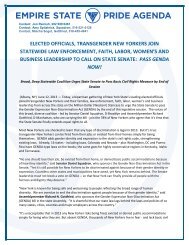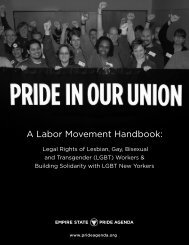<strong>Hate</strong> <strong>Violence</strong> Against <strong>Lesbian</strong>, <strong>Gay</strong>, <strong>Bisexual</strong>, Transgender, Queer and HIV-affected Communities in <strong>the</strong> U.S. in 2011NC<strong>AVP</strong>Scholars also estimate that 20-40% of homeless youth are LGBTQ. 54 Low-income LGBTQH youth and LGBTQHyouth of color who face homophobia or transphobia at home are more likely to become homeless or become partof <strong>the</strong> foster care system because of limited economic resources within <strong>the</strong>ir families and communities. While <strong>the</strong>ymay have LGBTQH-affirming family members or people in <strong>the</strong>ir communities, <strong>the</strong>se people may not have <strong>the</strong>means to financially support or assist <strong>the</strong>m. A 2009 study by <strong>the</strong> National Center for <strong>Lesbian</strong> Rights on LGBTyouth in <strong>the</strong> juvenile justice system entitled, ―Hidden Injustice: LGBT Youth in Juvenile Courts‖ found that morethan 90% of survey respondents identified a lack of family support as a serious problem for overcoming <strong>the</strong>irincarceration. 55 Young people, particularly LGBTQH and homeless youth, also tend to spend more time in publicspace making <strong>the</strong>m more vulnerable to hate violence, stranger based sexual violence, and hate motivated policeviolence. Since young people are particularly vulnerable to different types of violence at home, at school, and inpublic it is important to continue to educate service providers, school officials, and o<strong>the</strong>r agencies that work withyoung people on LGBTQH issues, and issues affecting LGBT youth in particular.The specific context of school-based anti-LGBTQH violence also can increase <strong>the</strong> likelihood for poverty forLGBTQH young people. A recent survey of transgender and gender non-conforming people in grades K-12reported alarming rates of harassment (78%), physical assault (35%) and sexual violence (12%); causing almost onesixth(15%) to leave a school in K-12 settings or in higher education. 56 Harassment, bullying, and discrimination areforms of violence in <strong>the</strong>mselves, but <strong>the</strong>se forms of violence also increase risk of dropping out of school forLGBTQH youth. The higher dropout rates for LGBTQ youth can create later employment barriers for LGBTQHyouth, particularly transgender youth and LGBTQH youth of color, resulting in engagement in sex work and sellingillegal drugs for survival. All of <strong>the</strong>se forms of employment can increase <strong>the</strong> risk of violence and can create barriersfor LGBTQH youth to seek assistance and support from law enforcement for <strong>the</strong> violence <strong>the</strong>y experienced. A2006 study showed that almost 60 percent of transgender youth of color had traded sex for money or resources. 57Once LGBTQH youth leave school it can be difficult to obtain sustainable employment, particularly for youth thatengage in underground economies, which can lead to criminal records creating more barriers to employment andbarriers to some forms of governmental assistance. Ensuring <strong>the</strong> safety of LGBTQH students in schools willprevent <strong>the</strong> structural conditions that put LGBTQH youth at risk of violence.54 National <strong>Gay</strong> and <strong>Lesbian</strong> Task Force, ―<strong>Lesbian</strong>, <strong>Gay</strong>, <strong>Bisexual</strong> and Transgender Youth: An Epidemic of Homelessness” (2006). Accessed from:http://www.<strong>the</strong>taskforce.org/reports_and_research/homeless_youth on May 20, 2012.55 National Center for <strong>Lesbian</strong> Rights, Hidden Injustice: <strong>Lesbian</strong>, <strong>Gay</strong>, <strong>Bisexual</strong>, and Transgender Youth in Juvenile Courts (2009). Accessed from:http://www.equityproject.org/pdfs/hidden_injustice.pdf on May 25, 2012.56 National Center for Transgender Equality and National <strong>Gay</strong> and <strong>Lesbian</strong> Task Force, ―Injustice at Every Turn‖ (2011). Accessed fromhttp://www.<strong>the</strong>taskforce.org/downloads/reports/reports/ntds_full.pdf on may 10, 2012.57 Garofalo R et al. Overlooked, misunderstood, and at risk: exploring <strong>the</strong> lives and HIV risk of ethnic minority male-to-female transgender youth. Journalof Adolescent Health 2006; 38(3): 230-6.48
<strong>Hate</strong> <strong>Violence</strong> Against <strong>Lesbian</strong>, <strong>Gay</strong>, <strong>Bisexual</strong>, Transgender, Queer and HIV-affected Communities in <strong>the</strong> U.S. in 2011NC<strong>AVP</strong>Police <strong>Violence</strong> Against Disproportionately Impacted CommunitiesWithin NC<strong>AVP</strong>’s person level data youth and young adults, transgender people, and transgender people of color allfaced an increased risk of hate violence. Although in 2011, we saw a decrease in overall reports of police hostilityand a slight increase in police reporting, NC<strong>AVP</strong>’s data suggests that <strong>the</strong>se issues are still pervasive for <strong>the</strong> mostmarginalized LGBTQH survivors and victims. Many NC<strong>AVP</strong> members supported LGBTQH survivors who werefalsely arrested, experienced violence, and/or were profiled based upon race, sexual orientation, gender identity, andgender expression. One common form of profiling, that many LGBTQH community members experience is policeofficers profiling LGBTQH people as sex workers. Ano<strong>the</strong>r form of police profiling is falsely arresting orselectively arresting LGBTQH couples for public displays of affection or sexual activity. As NC<strong>AVP</strong>’s datasuggests <strong>the</strong>se issues particularly affects transgender communities of color. To address <strong>the</strong>se conditions, policeofficers should be investigated for and face consequences for homophobic, biphobic, and transphobic violence andharassment. Policymakers should pass legislation and create policies to prohibit profiling based on race, genderexpression, and gender identity.Police officers also need to increase <strong>the</strong>ir knowledge on LGBTQH communities particularly LGBTQHcommunities of color, transgender communities, and LGBTQH youth. Federal, state, and local governmentsshould create legislation to require and fund <strong>the</strong>se trainings. These laws should require that LGBTQH specific antiviolenceorganizations directly provide <strong>the</strong>se trainings to ensure that police officers receive <strong>the</strong> most currentinformation on anti-LGBTQH hate violence. Policymakers should also ensure that <strong>the</strong>se trainings are evaluatedregularly to determine <strong>the</strong>ir impact on police attitudes, law enforcement knowledge of LGBTQH issues, andreducing anti-LGBTQH hate motivated police violence for a wide range of survivors and victims. Policymakersshould also create legislation and policies to document profiling based on gender identity, sexual orientation, andrace to have <strong>the</strong> best data possible to create remedies for <strong>the</strong>se issues. Federal, state, and local governments shouldrequire and fund police departments to create LGBTQH police liaisons, LGBTQH advisory committees, and o<strong>the</strong>rprograms to reduce barriers to law enforcement. The focus of <strong>the</strong>se programs should be to make sure LGBTQHpeople do not face homophobic, biphobic, and transphobic violence and harassment when engaging with <strong>the</strong>police.NC<strong>AVP</strong>’s data also shows that 48% of survivors do not report <strong>the</strong>ir incidents of violence to law enforcement. Thishighlights a continued need to for anti-violence programs to create community-based interventions that do not relyon <strong>the</strong> criminal legal system. These interventions could prove particularly supportive to meet <strong>the</strong> needs ofmarginalized LGBTQH communities many of who may be reluctant or face barriers in seeking support for <strong>the</strong>violence that <strong>the</strong>y experience. Community accountability efforts should be funded and evaluated to continue toprovide functioning alternatives where law enforcement is not supportive or adequate.It is also important to continue training service providers and first responders on how to best serve all LGBTQHsurvivors. These trainings should include appropriate terminology for LGBTQH communities, specific needs forLGBTQH survivors, common barriers that LGBTQH survivors face when accessing services, and addressstrategies to remedy <strong>the</strong>se barriers. Grantees should also receive incentives to revise <strong>the</strong>ir policies in order toincrease <strong>the</strong> amount of LGBTQH survivors that <strong>the</strong>y serve. Federal, state, and local governments should also fundheath care institutions to work with LGBTQH health and anti-violence organizations to ensure that health careproviders can meet <strong>the</strong> needs of LGBTQH survivors of violence. In particular, paramedics, emergency departmentstaff, and sexual assault examiners should receive specialized trainings on <strong>the</strong> needs of LGBTQH survivors andvictims. Programs such as <strong>the</strong> OVW-funded National LGBTQ Training and Technical Assistance Center currently49
- Page 1 and 2: Hate ViolenceAgainst Lesbian, Gay,B
- Page 3: Hate Violence Against Lesbian, Gay,
- Page 6 and 7: Hate Violence Against Lesbian, Gay,
- Page 8 and 9: Hate Violence Against Lesbian, Gay,
- Page 10 and 11: Hate Violence Against Lesbian, Gay,
- Page 12 and 13: Hate Violence Against Lesbian, Gay,
- Page 14 and 15: Hate Violence Against Lesbian, Gay,
- Page 16 and 17: Hate Violence Against Lesbian, Gay,
- Page 18 and 19: Hate Violence Against Lesbian, Gay,
- Page 20 and 21: Hate Violence Against Lesbian, Gay,
- Page 22 and 23: Hate Violence Against Lesbian, Gay,
- Page 24 and 25: Hate Violence Against Lesbian, Gay,
- Page 26 and 27: Hate Violence Against Lesbian, Gay,
- Page 28 and 29: Hate Violence Against Lesbian, Gay,
- Page 30 and 31: Hate Violence Against Lesbian, Gay,
- Page 32 and 33: Hate Violence Against Lesbian, Gay,
- Page 34 and 35: Hate Violence Against Lesbian, Gay,
- Page 36 and 37: Hate Violence Against Lesbian, Gay,
- Page 39 and 40: Hate Violence Against Lesbian, Gay,
- Page 41 and 42: Hate Violence Against Lesbian, Gay,
- Page 43 and 44: Hate Violence Against Lesbian, Gay,
- Page 45 and 46: Hate Violence Against Lesbian, Gay,
- Page 47: Hate Violence Against Lesbian, Gay,
- Page 51 and 52: Hate Violence Against Lesbian, Gay,
- Page 53 and 54: Hate Violence Against Lesbian, Gay,
- Page 55 and 56: Hate Violence Against Lesbian, Gay,
- Page 57 and 58: Hate Violence Against Lesbian, Gay,
- Page 59 and 60: Hate Violence Against Lesbian, Gay,
- Page 61 and 62: Hate Violence Against Lesbian, Gay,
- Page 63 and 64: Hate Violence Against Lesbian, Gay,
- Page 65 and 66: Hate Violence Against Lesbian, Gay,
- Page 67 and 68: Hate Violence Against Lesbian, Gay,
- Page 69 and 70: Hate Violence Against Lesbian, Gay,
- Page 71 and 72: Hate Violence Against Lesbian, Gay,
- Page 73 and 74: Hate Violence Against Lesbian, Gay,
- Page 75 and 76: Hate Violence Against Lesbian, Gay,
- Page 77 and 78: Hate Violence Against Lesbian, Gay,
- Page 79 and 80: Hate Violence Against Lesbian, Gay,
- Page 81 and 82: Hate Violence Against Lesbian, Gay,
- Page 83 and 84: Hate Violence Against Lesbian, Gay,
- Page 85 and 86: Hate Violence Against Lesbian, Gay,
- Page 87 and 88: Hate Violence Against Lesbian, Gay,
- Page 89 and 90: Hate Violence Against Lesbian, Gay,
- Page 91 and 92: Hate Violence Against Lesbian, Gay,
- Page 93 and 94: Hate Violence Against Lesbian, Gay,
- Page 95 and 96: Hate Violence Against Lesbian, Gay,
- Page 97 and 98: Hate Violence Against Lesbian, Gay,
- Page 99 and 100:
National Coalitionof Anti-Violence
- Page 101 and 102:
Hate Violence against Lesbian, Gay,
- Page 103:
Hate Violence against Lesbian, Gay,




